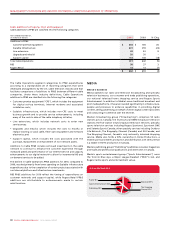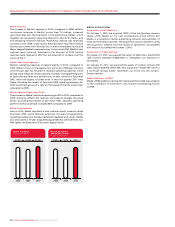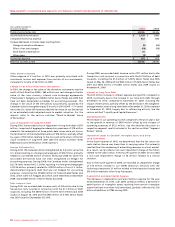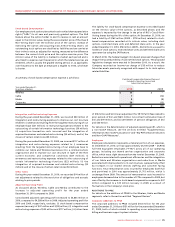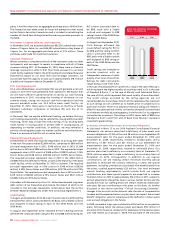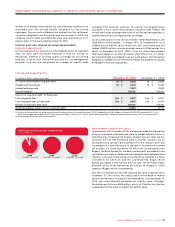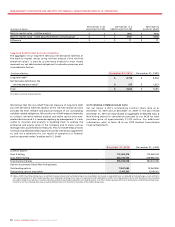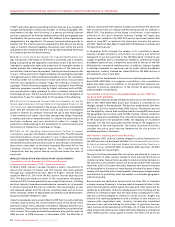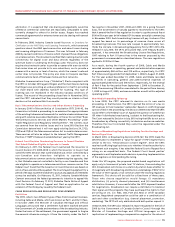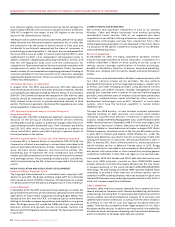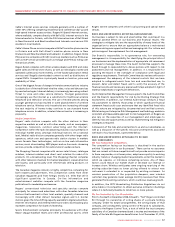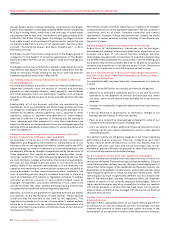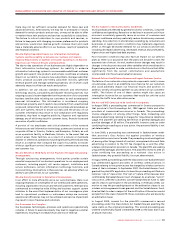Rogers 2010 Annual Report Download - page 45
Download and view the complete annual report
Please find page 45 of the 2010 Rogers annual report below. You can navigate through the pages in the report by either clicking on the pages listed below, or by using the keyword search tool below to find specific information within the annual report.
ROGERS COMMUNICATIONS INC. 2010 ANNUAL REPORT 49
MANAGEMENT’S DISCUSSION AND ANALYSIS OF FINANCIAL CONDITION AND RESULTS OF OPERATIONS
relieves us of primary responsibility for, and eliminates significant risk
associated with, the accrued benefit obligation for the retired
employees. The non-cash settlement loss arising from this settlement
of pension obligations was $30 million and was recorded in 2009. The
Company did not make any additional lump-sum contributions to its
pension plans in the year ended December 31, 2010.
INTEREST RATE AND FOREIGN EXCHANGE MANAGEMENT
Economic Hedge Analysis
For the purposes of our discussion on the hedged portion of long-term
debt, we have used non-GAAP measures in that we include all
Derivatives, whether or not they qualify as hedges for accounting
purposes, since all such Derivatives are used for risk management
purposes only and are designated as a hedge of specific debt
instruments for economic purposes. As a result, the Canadian dollar
equivalent of U.S. dollar-denominated long-term debt reflects the
contracted foreign exchange rate for all of our Derivatives regardless of
qualifications for accounting purposes as a hedge.
As discussed above in the section entitled “Debt Redemptions and
Termination of Derivatives”, in August 2010, RCI redeemed all of its
US$490 million 9.625% Senior Notes due 2011 and terminated the
related US$500 million notional principal amount of Derivatives. As a
result,onDecember31,2010,100%ofourU.S.dollar-denominated
debtwashedgedonaneconomicbasiswhile93%ofourU.S.dollar-
denominated debt was hedged on an accounting basis. The Derivatives
hedgingourUS$350million7.50%SeniorNotesdue2038donotqualify
as hedges for accounting purposes.
Mark-to-Market Value of Derivatives
In accordance with Canadian GAAP, we have recorded our Derivatives
using an estimated credit-adjusted mark-to-market valuation which is
determined by increasing the treasury-related discount rates used to
calculate the risk-free estimated mark-to-market valuation by an
estimated bond spread (“Bond Spread”) for the relevant term and
counterparty for each Derivative. In the case of Derivatives accounted
for as assets (i.e. those Derivatives for which the counterparties owe
Rogers), the Bond Spread for the bank counterparty was added to the
risk-free discount rate to determine the estimated credit-adjusted value
whereas, in the case of Derivatives accounted for as liabilities (i.e. those
instruments for which we owe the counterparties), Rogers’ Bond
Spread was added to the risk-free discount rate. The estimated credit-
adjusted values of the Derivatives are subject to changes in credit
spreads of Rogers and its counterparties.
The effect of estimating the credit-adjusted fair value of Derivatives at
December 31, 2010 versus the unadjusted risk-free mark-to-market
value of Derivatives is illustrated in the table below. As at December 31,
2010, the credit-adjusted estimated net liability value of Rogers’
Derivatives portfolio was $900 million, which is $17 million less than the
unadjusted risk-free mark-to-market net liability value.
Consolidated Hedged Position
(In millions of dollars, except percentages) December 31, 2010 December 31, 2009
U.S. dollar-denominated long-term debt US $ 5,050 US $ 5,540
Hedged with Derivatives US $ 5,050 US $ 5,540
Hedged exchange rate 1.1697 1.2043
Percent hedged(1) 100.0% 100.0%
Amount of long-term debt(2) at fixed rates:
Total long-term debt Cdn $ 9,607 Cdn $ 9,307
Total long-term debt at fixed rates Cdn $ 9,607 Cdn $ 9,307
Percent of long-term debt fixed 100.0% 100.0%
Weighted average interest rate on long-term debt 6.68% 7.27%
(1) Pursuant to the requirements for hedge accounting under Canadian Institute of Chartered Accountants (“CICA”) Handbook Section 3865, Hedges, on December 31, 2010, RCI accounted for 93.1% of its
Derivatives as hedges against designated U.S. dollar-denominated debt. As a result, 93.1% of our U.S. dollar-denominated debt is hedged for accounting purposes versus 100% on an economic basis.
(2) Long-term debt includes the effect of the Derivatives.
Fixed 100% Floating 0%Fixed 100% Floating 0%Fixed 93% Floating 7%
FIXED VERSUS FLOATING DEBT COMPOSITION
(% at December 31)
201020092008



